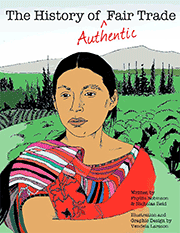The following article was written by Joanne Grisanti, Merchandising Manager at River Valley Market Food Coop, Northampton, MA
 In march, I had the good fortune to visit the tea lands of Darjeeling, India with an eight member delegation led by Equal Exchange. We went to visit a few of their producer partners, including the Potong Tea Garden, which is operating as a new business model.
In march, I had the good fortune to visit the tea lands of Darjeeling, India with an eight member delegation led by Equal Exchange. We went to visit a few of their producer partners, including the Potong Tea Garden, which is operating as a new business model.
At Potong, workers collectively run their tea garden and own 51%. If this experimental model is successful, it could transform the tea industry. We visited three models of tea gardens: The Singell Estate, which is still run as a plantation (although one in which the business and the people are well cared for); Mineral Springs Co-op, which is a mature, thriving, small farmer-owned co-op; and Potong Tea Garden, which is making history. All of these tea gardens work with the Tea Promoters of India (TPI), which advises them and markets their tea. TPI’s core philosophy is farming in harmony with nature. We traveled with the leadership of TPI, who escorted, educated, and looked after us.
As tea makes its way more deeply into U.S. culture, many Americans have learned that all tea comes from the same plant—Camellia sinensis. The specific way it is processed (drying, fermenting, wilting, etc) determines the end result, including type, quality, cut, and grade. About 250 years ago, the British brought tea from China to the remote foothills of the Himalayas. In this area, near Darjeeling, the tea has been tended by generations of families, many from nearby Nepal. Visually more garden than farm, tea crops grow on pruned trees or shrubby bushes that are about waist-high and are hand picked to a flat-top. In the cool mountains, the bushes live (and produce) for about 150 years.
A huge, sparsely developed country, India has only been independent from Britain since 1947, and still has remnants of colonialism in its laws. One remaining law restricts tea in India to be grown on plantations, so it is illegal to grow tea on your own land. The politics are evident: this law originally guaranteed that one of the most lucrative cash crops would remain controlled by wealthy (British) plantation owners and not by Indians.
TPI and Equal Exchange are working to change this.
Today, 98% of tea that is labeled “Fair Trade” is sourced from large-scale plantations with bonded labor and other feudal systems. However, when consumers buy tea grown by small farmers, they are helping to change the status quo and help more growers stay independent.
Our whirlwind trip began with a direct fourteen-hour flight to Delhi. The next morning, we took another two-hour flight east to Bagdogra, which is near the Chinese border. We flew near and parallel with the Himalaya Mountain range and I watched them for almost the entire flight, riveted, as they towered above us and the clouds, even as we flew above 32,000 feet.
Going to India is like entering a time warp, and you don’t know which “time” will be around any corner. The Bagdogra Airport (with its restaurant run by the Worker’s Co-operative Society, Ltd) was right out of Casablanca. Paved, three-lane roads led from the airport to the Chinese border (think military). The roads leading to our destination were narrow, steep, and bumpy.
In Bagdogra, we transferred to SUVs with Indian drivers and headed UP, UP, UP for about four hours. Driving is so dangerous, most vehicles have altars on their dashboards, or at minimum, a prayer wheel or devotional photos. Our driver said we need three things: good horn, good brakes, and good luck.
We passed endless tiny markets and teeny businesses, built on bamboo stilts and hanging over cliffs. Some still bravely boasted signs promoting “Gorkhaland,” a West Bengal independence movement which led to violent clashes in the 1980s—more than 1,200 people were killed. Others had signs with comical double entendres, such as “Good Luck Medicine.”
We passed towns and monasteries, going UP UP, past beautiful schoolchildren walking to and from school, in perfect uniforms, with proud smiles. We traveled endless switchbacks and rode on cliff edges, sometimes in total darkness. The roads are forty-five degrees steep and sometimes not wide enough for another vehicle to pass. My fellow delegates and I were white-knuckled and jittery with excitement.
The towns we passed were brown and dusty; sometimes the only color we saw were the saris of the women, who, in contrast, looked like flowers or exotic birds. Sometimes prayer flags spanned a ravine to remind us of the mountain spirits, or a road washout appeared when we least expected to see it. It is an area to stay on your toes.
As we traveled farther and farther UP, first to Kurseong, then Darjeeling, toward Nepal, the roads got steeper, the air got cooler and brisker, and the houses and buildings got more colorful: spring green, yellow, turquoise, coral, fuschia, plum, reds. We were almost there.
When I first saw the tea bushes, the gardens scattered with orange trees, I fell in love. I stood among emerald green bushes with their leaves shining in the sun—the smell of the plants was like jasmine or faint gardenia. I looked up the hill and saw dozens of women in brightly colored clothes, wearing big baskets, and tenderly picking small, new tea leaves. I worked alongside them and they taught me how to determine which leaves were ready and how to pick them. The experience was other-worldly and intoxicating. My love of tea leaped from adoration to obsession.
Darjeeling, or the “Champagne of teas,” is harvested intimately, by pruning the bush by hand, pinching off only “two leaves and a bud,” and returning to each bush about every seven days. The entire process of caring for the plants, harvesting, then processing tea is incredibly labor intensive and back breaking. In the fields, women carry bundles of straw three times their own size up steep mountain trails to tenderly mulch young tea plants, whose success is linked to their own future.
The workers picking tea make about $2.00 (US) per day. Fair Trade is important here. Since the Fair Trade world is being turned inside out, identifying small producers has become essential.
Since its inception, the tea industry was owned, run and controlled by the British. When they left, consequently, it collapsed. The tea lands were acquired by the new Indian state and were leased to certain business owners who continued to operate them as plantations. The history and personality of each plantation is unique, but they were all modeled after the US slavery system, through which families were owned, worked, minimally housed, and fed. The owner of the plantation is responsible for the land, crops, buildings, factories, and welfare of the people, hundreds of them, many of whom have lived on the land for generations, have no other skills, and know no other way of life.
In the 1970s, Russia was very involved in the tea trade. Tea was sold at such low prices that the system collapsed again, many plantations were abandoned and the people were left to starve. This is what happened at Potong.
In the 1990s, after the breakup of the Soviet Union, TPI, a family business started marketing tea all over the world. We visited three of TPI’s partner tea gardens.
The Singell Tea Estate was planted in 1862 as a plantation. In 1978, the government took over Singell when it was struggling to survive, and installed managers. It is now operated by TPI. In 1994, Singell was Fair Trade and Demeter (biodynamic) certified. Although its former owners were British, the owners and managers are now all Indian, and the workers (still) mostly Nepalese. It is a well-run operation and also processes all of the tea picked at Mineral Spring, Potong, and other nearby gardens. It is sometimes referred to as the “Mother Factory.”
The Mineral Spring co-op is a plantation that was abandoned in the mid-1950s. Most tea workers here are now from the next generation. Mineral Spring features a terraced slope and forest and, when abandoned, was totally overgrown for fifteen years. The land was passed back and forth between the government and others. TPI was invited in and worked on a revolutionary new model where the workers were involved in management of the garden. Every house could have its own tea bushes, and its own steady income, instead of its employees working only for others. The project became successful and now, due to a loophole in the plantation law, Mineral Spring Co-op is owned by the small farmers themselves. Today, it is the only 100% farmer-owned tea garden in India. The terraced mountains are speckled with colorful, cozy homesteads and permaculture farms hidden in the jungle amid winding paths, remnants of stone walls left from colonial times, orchids, cows, chickens, mango trees, pineapples, avocados, oranges, huge stands of bamboo, and roaming leopards and wild boars. The farmers refer to this as their neighborhood.
Mineral Spring Co-op is made up of fourteen hamlets, each of which has elected representation and its own tea collectors. The garden was certified Organic in 2001 and certified Fair Trade in 2003. The co-op has officers, a women’s group, an annual newsletter, and internal controls. They even hired a member to work on databases. Understanding that monoculture farming is never the most sustainable model, they plan to eventually grow a small variety of cash crops: tea, ginger, cardamom, vegetables, turmeric, chamomile, etc. Challenges that they still face include the need for electricity, need to increase production, isolation (they speak Nepalese only), and the need for a new young leadership to continue to emerge.
Potong Tea Garden, located in the foothills of the Himalayas, is now collectively run by its workers. It was previously abandoned by the government, its assets sold off by the court, and its factory left to rust. Large areas of the garden were burned and abandoned. Many owners came and went and there were many years of uncertainty. The workers and their families had no income. More and more young people were leaving the gardens for the cities. Many came back with new diseases, including AIDS. Dozens from the community died.
An investor from Kolkata [Calcutta] bought the enterprise without knowing tea. In 2005, they approached TPI and a novel idea was born: Make the garden 51% worker owned, 25% TPI owned, and 24% privately owned. TPI would provide technical assistance and market support, and the workers would always retain a controlling share. There was much opposition to this model, including resistance from politicians and trade unions, but they persevered; conditions are improving and the garden is now planting thousands of new tea trees. Less than five years ago, the Potong were dying due to lack of food; now 2,500 people rely on the garden, and it employs about 350 people. Their pride and self-assurance are inspiring and humbling.
TPI states that when capitalized, Potong will produce the finest tea in Darjeeling. Only 60% of the land is in production now. Last year, Equal Exchange invested $15,000 for the planting of 30,000 new tea plants in Potong. This October, Equal Exchange is donating more trees. To help with this effort, watch this video.

Read Full Post »

























